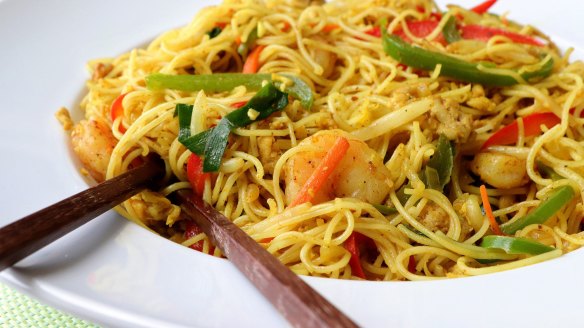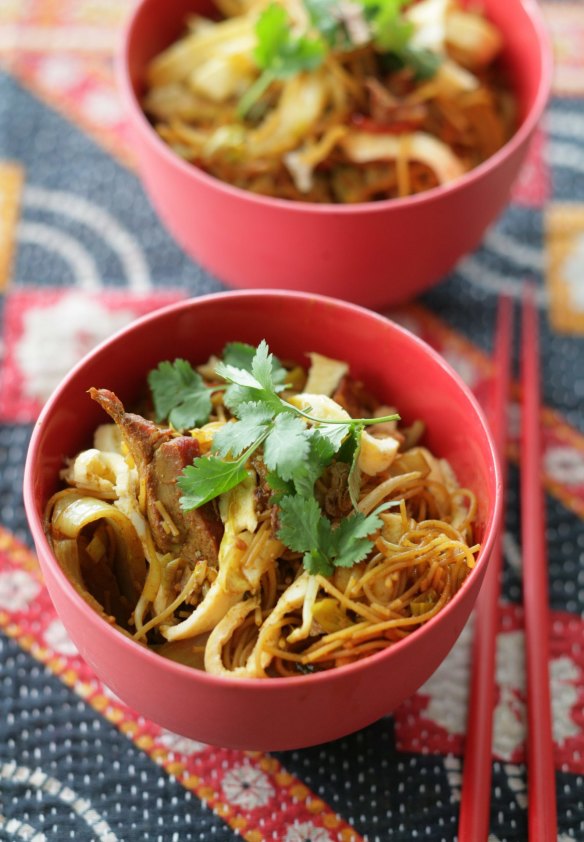How to make Singapore noodles

Some people claim that Singapore noodles aren't authentic.
That's nonsense, of course. They are plenty authentic. They just aren't authentically from Singapore.

French toast was not invented in France, but a version of it can be eaten there. It's like that for Singapore noodles, only Singapore noodles are almost completely unknown in Singapore.
Often found on the menus of Chinese restaurants, Singapore noodles are a diner's delight: lightly curried, thin, dry noodles tossed with a selection of vegetables and a meat, such as chicken or prawns, or a vegetarian protein such as tofu.
At its heart, it is a street food, although it doesn't seem to be sold on the street anywhere. It is a restaurant food that ought to be sold on the street – and someone could make a good living doing it.
Singapore noodles is a popular dish in Cantonese takeaway restaurants in China and especially in Hong Kong, where many proud residents claim it was invented. That assertion makes sense, because the dish relies on curry powder, and curry powder is a British invention (they were trying to recreate the complex flavours of India in a single spice mix).
England colonised Hong Kong and brought curry powder with them. Let's give Hong Kong tentative credit for creating it.
I'm glad they did. I am such a fan, I decided to make Singapore noodles for myself. I perused several recipes, took the best ideas from a few of them (two in particular) and mashed them together to create Singapore noodles so good that even people in Singapore would eat them.
Obviously, you begin with the noodles themselves. The dish calls for rice vermicelli, which is probably easiest to find at an Asian grocer (though many supermarkets carry it on their international shelves).
Vermicelli comes in a variety of widths. You want the thin kind. If possible, get a kind that has not been packed too tightly into the package; this will make it easier to soak.
I used prawns, which is always good in Singapore noodles and basically everything else. Traditionally, sliced Chinese barbecue pork called char siu is also used, but I didn't want to go to the considerable effort to make it, so I got chicken mince instead.
Singapore noodles are made in two parts: a sauce and a stir-fry. Relatively little sauce is needed, because the overall effect should be dry noodles. However, because you are using so little of it, the sauce has to be packed full of flavour: curry powder, sesame oil, dry sherry (or shao hsing wine), pepper, a little sugar to temper it and some turmeric to give it the familiar yellow colour.
The stir-fry is not unlike many other stir-fries: onions, garlic, ginger, carrots, capsicum (I used both red and green to add colour) and beansprouts. I used garlic chives but spring onions will do just fine.
I used peanut oil because it can stand up to the high heat necessary for stir-frying. It also adds a nice hint of peanut flavour to the dish. Vegetable oil, grapeseed oil and sunflower oil are also good choices, but never use an oil with a low smoke point, such as olive oil, because it will quickly burn and ruin your dish.
One unusual addition, but absolutely necessary (more or less) for Singapore noodles is an egg, scrambled into the stir-fry.
One final word about the technique: this version of Singapore noodles requires stir-frying many of the ingredients individually. The idea is to let the ingredients release their moisture, which will keep the delicate noodles from becoming mushy.
The result is perfect Singapore noodles. They may not recognise it in Singapore, but the rest of the world will love it.
Singapore noodles
INGREDIENTS
170g dried vermicelli rice noodles
1½ tbsp dry sherry or Shaoxing wine
3 tsp curry powder
1 tsp salt
½ tsp sesame oil
½ tsp sugar
¼ tsp white pepper
¼ tsp ground turmeric
2 tbsp peanut oil (or grapeseed, sunflower or vegetable oil)
2 large eggs, beaten well
225g chicken mince or thinly sliced Chinese barbecue pork (char siu)
½ small onion, chopped
2 cloves garlic, minced
½ large carrot, thinly julienned
2 tsp minced ginger
½ green capsicum*, thinly sliced
½ red capsicum*, thinly sliced
85g beansprouts
3 garlic chives or spring onions, cut into 5cm pieces
225g prawns, peeled and deveined
METHOD
1. Cook vermicelli noodles in boiling water for one and a half minutes. Drain without rinsing, place still hot in a large bowl and cover with a tea towel. Let stand 10 minutes. Pull on the noodles with tongs, chopsticks or clean hands to separate them. If the noodles are too long for easy eating, cut them into smaller pieces. Set aside.
2. In a small bowl, combine the sherry or shao hsing wine, curry powder, salt, sesame oil, sugar, white pepper and turmeric. Stir to mix well, and set aside.
3. Heat half a tablespoon of the peanut oil in a wok or large non-stick skillet over medium-high heat. Add the eggs and scramble until just cooked through. Transfer to a plate.
4. Clean wok or skillet if necessary. Add another half tablespoon of the peanut oil over medium heat. When hot, add the chicken mince or sliced char siu and cook, breaking up the ground chicken, until cooked through. Transfer to the plate with the eggs.
5. Add the remaining one tablespoon peanut oil. When hot, stir in onion, garlic, carrots, ginger and green and red capsicum. Stir fry until the vegetables have just softened, about three or four minutes. Stir in the beansprouts and garlic chives or spring onions and cook until they are heated through and beginning to take on some colour, one to two minutes. Remove to a plate.
6. Add prawns and stir fry until firm and thoroughly cooked (the time will depend on the size of the prawns). Remove to a plate.
7. In quick succession, add the reserved sauce, one-third cup of water and the noodles. Cook, stirring, until the noodles have absorbed all of the sauce and are uniform in colour. If some of the sauce sticks to the bottom of the pan, add a little more water. Add the eggs, chicken, vegetables and shrimp all back to the pan and mix everything together with chopsticks or tongs. Serve immediately.
Serves 4
*Note: Using red and green capsicum adds colour, but use one whole capsicum of one or the other colour if you wish to save the expense.
TNS
Appears in these collections
The best recipes from Australia's leading chefs straight to your inbox.
Sign up- More:
- How to